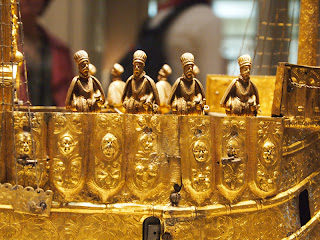Our weekends in London are a mixture of activities, we try and see something new to us both and because muse is fresh to these islands, something new to him.
Saturday, we headed east, to Spitalfields which is home to several markets as well as London's oldest. There has been a market here since 1638 when Charles I gave licence to sell flesh, fowl and roots.
This area is also famous for its historic association with the silk industry established here by the Huguenots (French Protestants, made refugees after the Revocation of the Edict of Nantes in 1685).
We also know that the area was in use during Roman times, due to major archaeological excavations of a cemetery in the 1990's; based on observations made in 1576.
We wandered around the indoor marketplace and poked around a couple of the shops before heading off to explore the wider area including Brick Lane and mingle with the hip and cool.
Sunday was cloudy, we took ourselves off to the British Museum, muse has never been.
Muse wanted to specifically see some iron age artefacts, but I wasn't entranced by the iron pieces made during that period ...no it was the gold that caught my eye, it was so intricate and beautiful, take a look.
This is 'The Mold gold cape'. It is thought to be for ceremonial use only and was found by workmen quarrying for stone in an ancient burial mound in 1833. The mound lay in a field named Bryn yr Ellyllon in Welsh, (translated to English - the Fairies' or Goblins' Hill).
The following pictures are of gold worked into jewellery during the iron age which in Europe was the period between 1200BC and 400AD.
 |
We also took a look in the Clocks and Watches room, guess what? I found more gold, how about this for a clock? Actually most of it is gilded brass.
'The Mechanical Galleon', strictly speaking it is not a clock, it is an automan designed to announce a banquet by travelling independently along a table. As it went it along it would play a tune and drumsticks would play on a skin stretched across the base of the ships hull. For the grand finale it would fire the main cannon which then ignited a fast burning fuse which would burn around the hull firing off the other cannons in turn.
I love how intricate these little figures are.
On our way out we stopped at the Enlightenment Gallery formerly called the King's Library; it displays a wide range of objects relating to the Enlightenment, including the rosetta stone.
(Taken from Wiki) The Age of Enlightenment (or simply Enlightenment) was a cultural movement of intellectuals in the 17th and 18th centuries, which began in Europe and latterly in the American colonies. Its purpose was to reform society using reason, challenge ideas grounded in tradition and faith and advance knowledge through the scientific method.
I like a finely turned ankle.
This one, by the way belongs to Hermes the messenger of the gods, intercessor between mortals and the divine (if you hadn't already guessed).























1 comment:
What a fabulous weekend! I love the British Museum. One day is certainly not enough! How lovely to have a wedding in the works! Happy birthday again!
Post a Comment